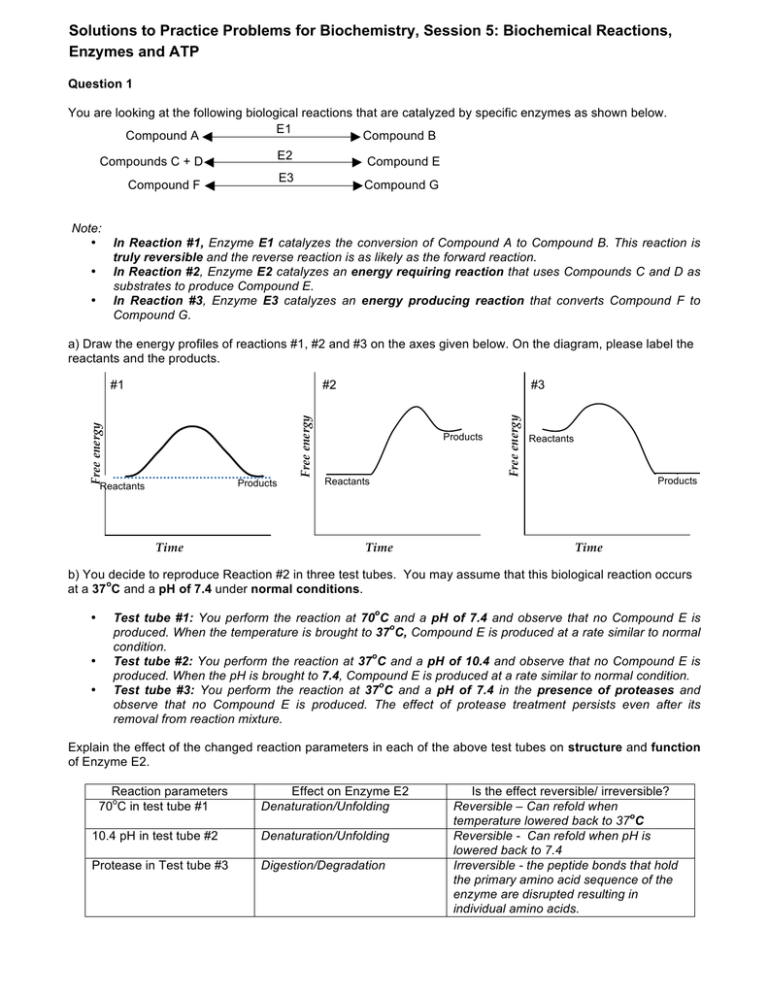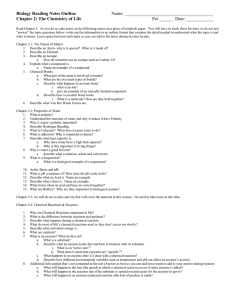Biochemistry Practice Problems & Solutions: Enzymes, ATP
advertisement

Solutions to Practice Problems for Biochemistry, Session 5: Biochemical Reactions, Enzymes and ATP Question 1 You are looking at the following biological reactions that are catalyzed by specific enzymes as shown below. E1 Compound A Compound B E2 Compounds C + D Compound E E3 Compound F Compound G Note: • In Reaction #1, Enzyme E1 catalyzes the conversion of Compound A to Compound B. This reaction is truly reversible and the reverse reaction is as likely as the forward reaction. • In Reaction #2, Enzyme E2 catalyzes an energy requiring reaction that uses Compounds C and D as substrates to produce Compound E. • In Reaction #3, Enzyme E3 catalyzes an energy producing reaction that converts Compound F to Compound G. a) Draw the energy profiles of reactions #1, #2 and #3 on the axes given below. On the diagram, please label the reactants and the products. Free energy Products Reactants Time #3 Products Reactants Time Free energy #2 Free energy #1 Reactants Products Time b) You decide to reproduce Reaction #2 in three test tubes. You may assume that this biological reaction occurs o at a 37 C and a pH of 7.4 under normal conditions. • • • o Test tube #1: You perform the reaction at 70 C and a pH of 7.4 and observe that no Compound E is o produced. When the temperature is brought to 37 C, Compound E is produced at a rate similar to normal condition. o Test tube #2: You perform the reaction at 37 C and a pH of 10.4 and observe that no Compound E is produced. When the pH is brought to 7.4, Compound E is produced at a rate similar to normal condition. o Test tube #3: You perform the reaction at 37 C and a pH of 7.4 in the presence of proteases and observe that no Compound E is produced. The effect of protease treatment persists even after its removal from reaction mixture. Explain the effect of the changed reaction parameters in each of the above test tubes on structure and function of Enzyme E2. Reaction parameters o 70 C in test tube #1 Effect on Enzyme E2 Denaturation/Unfolding 10.4 pH in test tube #2 Denaturation/Unfolding Protease in Test tube #3 Digestion/Degradation Is the effect reversible/ irreversible? Reversible – Can refold when o temperature lowered back to 37 C Reversible Can refold when pH is lowered back to 7.4 Irreversible - the peptide bonds that hold the primary amino acid sequence of the enzyme are disrupted resulting in individual amino acids. c) An enzyme may alter some or all of the following parameters. For each choose whether the enzyme would “increase” or “decrease” that parameter. If the enzyme does not affect that parameter, write “no change”. Parameter Effect of enzyme Free energy of the products no change Rate of forward reaction increase Rate of reverse reaction increase Energy of activation decrease Overall free energy change no change Question 2 a) On the axes below, draw and label the products and reactants, ΔG, and energy of activation for reaction 1 below. B, where the forward reaction has a ΔG = -3, and an Energy of activation = +0.5 Free energy (kcals/mole) 1) A Energy if activation 4 Reactants 3 ΔG 1 Products Course of reaction Compare reaction 1 (above) to reactions 2 and 3 (below). 2) C 3) E D, where the forward reaction has a ΔG = +2, and an Energy of activation = +2.5 F, where the forward reaction has a ΔG = +0.3, and an Energy of activation = +2 b) Which of these reactions, 1, 2, or 3 is most likely to proceed in the forward direction in the absence of an enzyme? If you do not have enough information to answer this question, write “Can’t tell” below. Explain your answer. Reaction 1 is most likely to proceed in the forward direction in the absence of an enzyme because it is exergonic (the ΔG is negative) and the energy of activation is low compared to the other two reactions. c) Which of these reactions, 1, 2, or 3 will have the larger Keq? If you do not have enough information to answer this question, write “Can’t tell” below. Explain your answer. Reaction 1 will have a larger Keq. The free energy of the products is much less than the free energy of the reactants, thus the forward reaction is favored, and at equilibrium, there will be more products than reactants. d) Assume that you have a reaction X Y where ΔG = 0 and the energy of activation = 0.6 kcal/mole. In a cell, you find that the reaction proceeds almost exclusively in the forward direction. Explain why this might be the case. In a cell, the product can be used as soon as it is produced. This consumption of the product prevents the reverse reaction for occurring and drives the reaction in the forward direction. MIT OpenCourseWare http://ocw.mit.edu 7.01SC Fundamentals of Biology Fall 2011 For information about citing these materials or our Terms of Use, visit: http://ocw.mit.edu/terms.




